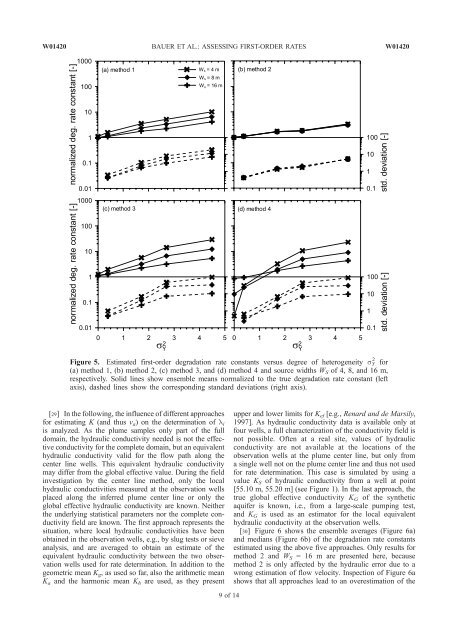Applied numerical modeling of saturated / unsaturated flow and ...
Applied numerical modeling of saturated / unsaturated flow and ...
Applied numerical modeling of saturated / unsaturated flow and ...
Create successful ePaper yourself
Turn your PDF publications into a flip-book with our unique Google optimized e-Paper software.
W01420 BAUER ET AL.: ASSESSING FIRST-ORDER RATES<br />
Figure 5. Estimated first-order degradation rate constants versus degree <strong>of</strong> heterogeneity sY 2 for<br />
(a) method 1, (b) method 2, (c) method 3, <strong>and</strong> (d) method 4 <strong>and</strong> source widths WS <strong>of</strong> 4, 8, <strong>and</strong> 16 m,<br />
respectively. Solid lines show ensemble means normalized to the true degradation rate constant (left<br />
axis), dashed lines show the corresponding st<strong>and</strong>ard deviations (right axis).<br />
[29] In the following, the influence <strong>of</strong> different approaches<br />
for estimating K (<strong>and</strong> thus va) on the determination <strong>of</strong> li<br />
is analyzed. As the plume samples only part <strong>of</strong> the full<br />
domain, the hydraulic conductivity needed is not the effective<br />
conductivity for the complete domain, but an equivalent<br />
hydraulic conductivity valid for the <strong>flow</strong> path along the<br />
center line wells. This equivalent hydraulic conductivity<br />
may differ from the global effective value. During the field<br />
investigation by the center line method, only the local<br />
hydraulic conductivities measured at the observation wells<br />
placed along the inferred plume center line or only the<br />
global effective hydraulic conductivity are known. Neither<br />
the underlying statistical parameters nor the complete conductivity<br />
field are known. The first approach represents the<br />
situation, where local hydraulic conductivities have been<br />
obtained in the observation wells, e.g., by slug tests or sieve<br />
analysis, <strong>and</strong> are averaged to obtain an estimate <strong>of</strong> the<br />
equivalent hydraulic conductivity between the two observation<br />
wells used for rate determination. In addition to the<br />
geometric mean Kg, as used so far, also the arithmetic mean<br />
Ka <strong>and</strong> the harmonic mean Kh are used, as they present<br />
9<strong>of</strong>14<br />
W01420<br />
upper <strong>and</strong> lower limits for Kef [e.g., Renard <strong>and</strong> de Marsily,<br />
1997]. As hydraulic conductivity data is available only at<br />
four wells, a full characterization <strong>of</strong> the conductivity field is<br />
not possible. Often at a real site, values <strong>of</strong> hydraulic<br />
conductivity are not available at the locations <strong>of</strong> the<br />
observation wells at the plume center line, but only from<br />
a single well not on the plume center line <strong>and</strong> thus not used<br />
for rate determination. This case is simulated by using a<br />
value KS <strong>of</strong> hydraulic conductivity from a well at point<br />
[55.10 m, 55.20 m] (see Figure 1). In the last approach, the<br />
true global effective conductivity KG <strong>of</strong> the synthetic<br />
aquifer is known, i.e., from a large-scale pumping test,<br />
<strong>and</strong> KG is used as an estimator for the local equivalent<br />
hydraulic conductivity at the observation wells.<br />
[30] Figure 6 shows the ensemble averages (Figure 6a)<br />
<strong>and</strong> medians (Figure 6b) <strong>of</strong> the degradation rate constants<br />
estimated using the above five approaches. Only results for<br />
method 2 <strong>and</strong> WS = 16 m are presented here, because<br />
method 2 is only affected by the hydraulic error due to a<br />
wrong estimation <strong>of</strong> <strong>flow</strong> velocity. Inspection <strong>of</strong> Figure 6a<br />
shows that all approaches lead to an overestimation <strong>of</strong> the

















